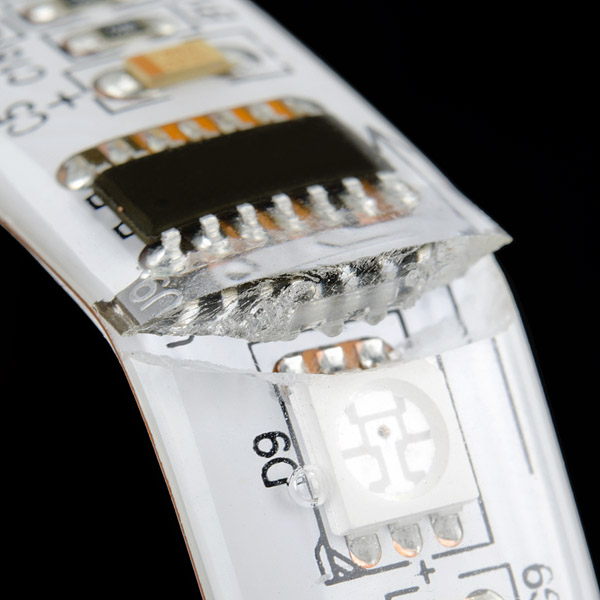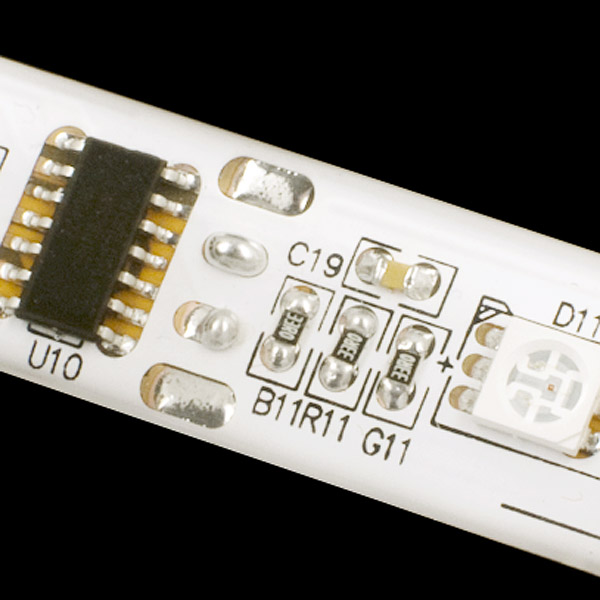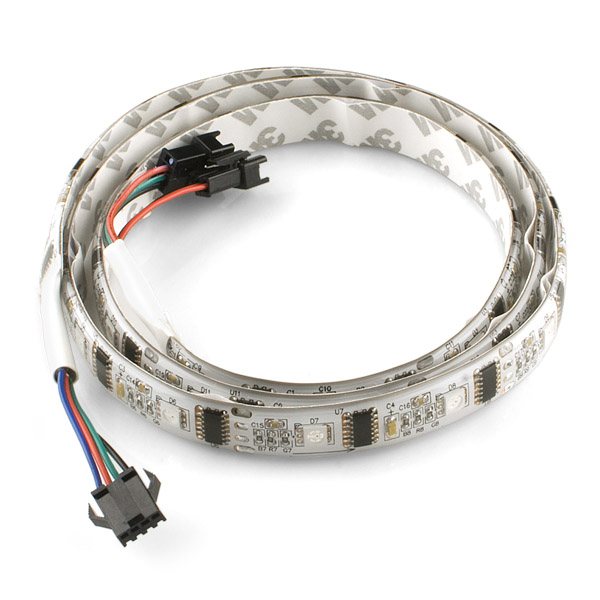RGB LED Strip - 32 LED/m Addressable - Ding and Dent
Replacement: None. This was a limited ding and dent item and we no longer carry them. You can check the LED category for more LEDs, also keep a look out for more ding and dent deals. This page is for reference only.
Ding and Dent: These strips came to us when they weren't fully cured. When we packaged them up, the coating on some cracked, as you can see in the picture. We hand-tested each strip and they all work, but they have one or more cracks in the outer coating. These cracks prevent them from being waterproof, so we are selling them at a discount. Most only have one or two cracks, maximum. This is a limited stock and when it's gone, we don't expect to get more, so get them while they last!
This RGB LED strip allows you to individually control all 32 RGB LEDs on a ~~waterproof~~, self-adhesive strip. Each LED has its own WS2801 IC and current limiting resistors. Check the example code and datasheets below for more information on how to drive these strips.
Each 1m section comes preterminated with a 0.1" spaced connectors. Connector may be different from what is pictured. Please see example code for termination explanation.
- Datasheet (FLB-W5050RGB-16-5-N14)
- Datasheet (WS2801)
- Example Code
Comments
Looking for answers to technical questions?
We welcome your comments and suggestions below. However, if you are looking for solutions to technical questions please see our Technical Assistance page.
Customer Reviews
No reviews yet.




Here is a real specific question: On a scale from one to one million (log), how difficult would it be to peel the entire plastic coating stuff off without ruining anything? Or, you can simply guesstimate if it is doable with a yes, no, maybe?
Extremely plausible!! As i've done it myself...
That would be difficult to do. The silicon rubber makes a pretty strong bond with the parts and flexible circuit board.
Not too likely...
Might want to strike out the "waterproof" part of the description, since they're explicitly not.
Duh. Thanks!
So I think I've hooked mine (1m strip) up to my Arduino like the example code needs, and nothing turns on at all, whether powered from USB or a 9v/1000mA wall wart. Any tips on how I can figure out what's wrong, or links to a more thorough walk through for using one of these with an Arduino?
An Arduino alone will not drive these. You need to drive them with a MOSFET (check out our power driver shield). Re-read the comments in the example code at the top. Also, the addressables can't be powered directly with 9V, you need to send it a signal to tell them to turn on or off.
Received mine, and I have a stuck pixel :(
One red led towards one end is stuck at about 15% brightness...next test is to see if its flashing pwm (broken driver) or just tiny current shorting somewhere -- green and blue are flawless.
The one I paid full price for arrived with 2 splits like those illustrated. How long does it take
for them to finish curing? Mine is still outgassing after weeks.
You shoulda asked them for a refund or credit... if they're nice they might still give ya one. Woulda been better if you'd sent them something about it when the product first showed up though, but I know maybe the waterproofness wasn't an issue for you so you didn't sweat it at the time...
Kudos to sparkfun for the significant markdown on these... or significant lack of markup I guess. ;D I'm hoping in time they list more of the "trimmings" of the other non-addressable RGB strips, those were all sold out by the time I saw them...
These are going fast!
Are the other non-cracked areas more prone to cracking now? As in if i try to bend them are they going to crack In more places? Or have they "cured" completely?
Thanks!
If I'm ordering 10m worth, is it possible to get it in one continuous piece? I'd be cutting it to odd sizes that wouldn't fit the 1m size all that well...
Sorry, they are already terminated in 1M sections.
Is this a 1m strip?
Yes it is. Sorry about that.